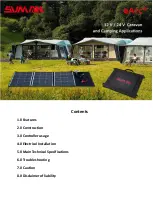
aleo
aleo solar Deutschland GmbH
| Osterstraße 15| 26122 Oldenburg | Germany | [email protected]
Page 16/60
installation instructions Edition 01/2012 en-GB-Intl (120508b)
More information on possible substructure variations can be
found in:
Ch. 5.9.4, 'Asymmetrical and symmetrical
clamping'
Ch. 5.9.5, 'Differing mounting rail intervals in
rows/columns'
Ch. 5.9.6, 'Identical mounting rail intervals in
rows/columns'
When using a lay-in system, only mount the modules in a line
on the long side. Also, please observe the guidelines provided
by the mounting system manufacturer.
Details can be taken from the diagrams in Ch. 9, 'Mechanical
Mounting Details'.
In-roof installation
Only mount aleo modules with the long side supported along
its entire length. Also, please observe the guidelines provided
by the mounting system manufacturer.
Details can be taken from the diagrams in Ch. 9, 'Mechanical
Mounting Details'.
Free-field installation
Attach the aleo modules to at least four support points as per
an on-roof installation.
When using a lay-in system, modules may be lined up on both
the long and short sides. Also, please observe the guidelines
provided by the mounting system manufacturer.
Details can be taken from the diagrams in Ch. 9, 'Mechanical
Mounting Details'.
5.9.2.
Installation orientation of the modules
Vertical installation (portrait orientation)
When using vertical installation, mount the modules in such a
way that the outlets for the cables on the module or its
junction box point towards the ground. This prevents water
penetration. This also applies to modules without their own
connecting cables.
Fig. 7 Correct position of the junction boxes when mounted
vertically
Horizontal installation (landscape orientation)
In horizontal installation, try to mount the modules in such a
way that the outlets for the cables on the modules or their
junction boxes are on the inside of the photovoltaic generator.
Avoid the area along the edge of the photovoltaic generator.
Doing so will help minimise the influence of the local environ-
mental conditions such as wind or rain. This recommendation
correspondingly also applies to modules without their own
connecting cables.
Fig. 8 Recommended position of the junction boxes when
mounted horizontally
5.9.3.
Clamp installation
Ensure that there are:
sufficient clamp and support areas so that the aleo
modules remain firmly fastened to the substruc-
ture, even under high loads;
open drainage holes for the drainage of water from
the hollow frame.
Clamping on the long sides
Clamp aleo modules preferably on the long sides.
Clamping to the short sides
Clamping aleo modules by their short sides is also an option.
Make sure that the modules are only clamped symmetrically.
5.9.4.
Asymmetrical and symmetrical clamping
The actual pressure load expected at the installation site
determines the correct way to clamp the modules.
In most cases, there is a degree of freedom during planning
regarding how to select the spacing of the mounting rails, e.g.
in order to be able to adapt the orientation to existing tile
rows. This can simplify the installation process and reduce
costs.
Asymmetrical clamping provides the greatest number of
options because even within a module row (or column, see
below) the clamp interval to the nearest corner on a module
side can vary.
There are also some variations for symmetrical clamping.
Within a module row (or column), the clamp interval to the
nearest corner of a module side is always the same. This
interval can, however, be varied for each module row
(column).
GID AS008b
GID AS009b
















































